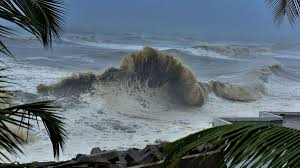Context:
Recently, INCOIS has issued alerts about the possibility of the ‘Kallakkadal’ phenomenon in the coastal areas of Kerala and Tamil Nadu.
More on the news
- People have also been advised to completely avoid travelling to the beaches and fishermen have been instructed to securely moor their fishing vessels in the harbor.
- Indian National Centre for Ocean Information Services (INCOIS), has predicted a possibility of rough seas due to high waves of 0.5 to 1.5 metres during the phenomenon.
INCOIS
- It was established as an autonomous body in 1999, under the Ministry of Earth Sciences (MoES).
- It monitors and provides information and advisory services for the coastal population on tsunamis, storm surges, high waves, etc.
What is Kallakkadal?
- Kallakadal, literally meaning “a sea that comes suddenly like a thief,” is a phenomenon that causes a sudden surge in sea waves, leading to coastal flash floods.
- These floods occur without any noticeable changes in the coastal environment, which typically serve as early warnings for such events.
However, early warning systems like the Swell Surge Forecast System —launched by the Indian National Centre for Ocean Information Services (INCOIS) in 2020 — give forewarning seven days in advance. - The term ‘Kallakadal’ was officially approved by the United Nations Educational, Scientific and Cultural Organization (UNESCO).
How is the Kallakkadal phenomenon formed?
- These events are caused by specific meteorological conditions in the Southern Indian Ocean south of 30°S.
- The Long-period swells generated in the Southern Indian Ocean travel northward and reach Indian coasts in 3-5 days, causing havoc in coastal areas. Thus, they are infamously also known as swell surges.
- It is mostly caused by distant storms such as hurricanes or long periods of fierce gale winds. During such storms, a massive transfer of energy occurs from the air to the water, resulting in the formation of extremely high waves.
- These waves can travel thousands of kilometers from the storm center before reaching the shore.
How is Kallakkadal different from the tsunami?
- Kallakkdal is often mistaken with a tsunami which emerges due to seismic activity like earthquakes, underwater landslides or volcanic eruptions. kallakkadal, on the other hand, is caused by strong winds or storms.
Also Read:
Indian Scientists Develop Tool to Generate Star Catalogue for Thirty Meter Telescope

